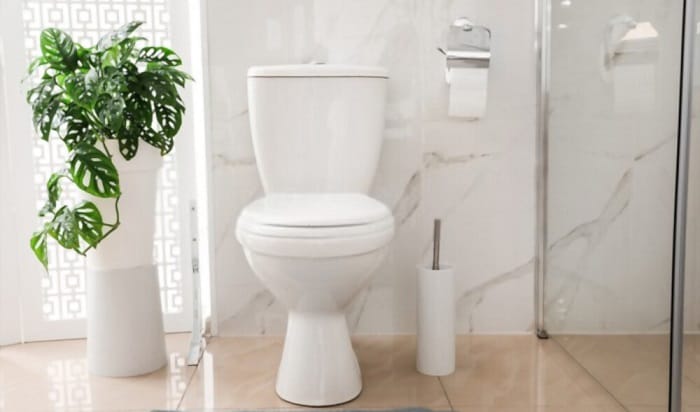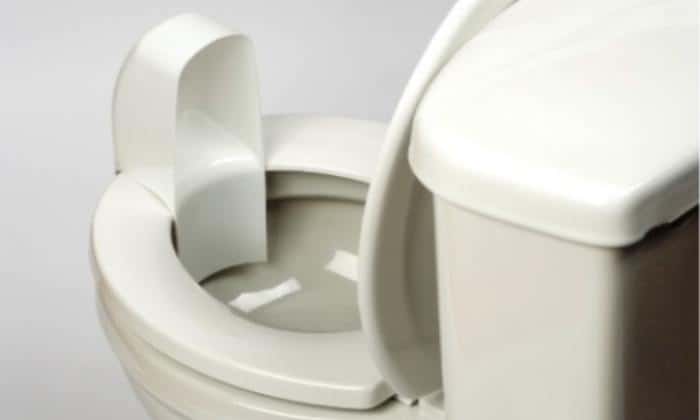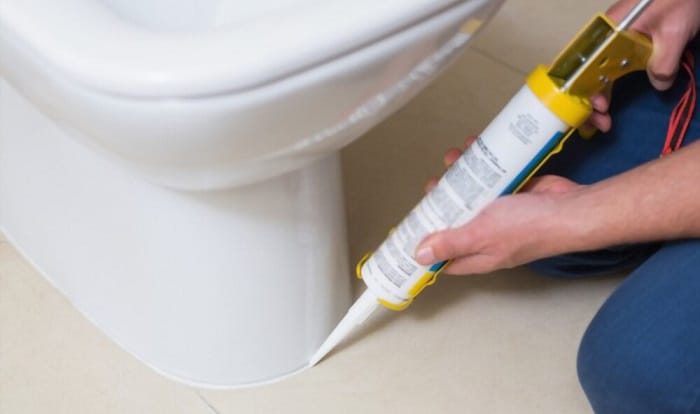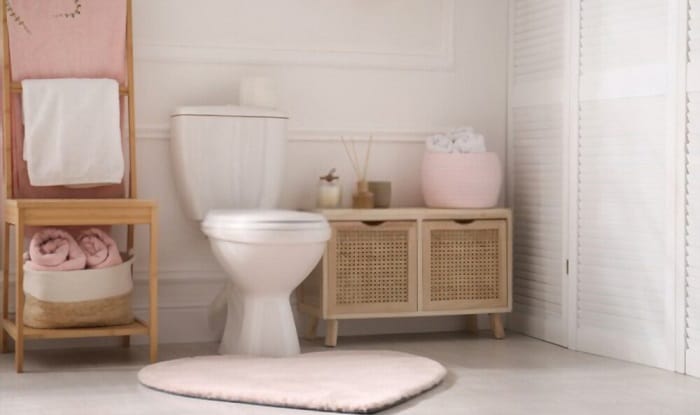How to Protect Bathroom Floor From Urine? – 7 Solutions
Urine backsplash is never pleasant – it’s unsanitary and often results in a reeky bathroom. The problem doesn’t really stop there either, as it can lead to tough stain around toilet base that never washes ... Read more The post How to Protect Bathroom Floor From Urine? – 7 Solutions appeared first on Arthitectural.


Urine backsplash is never pleasant – it’s unsanitary and often results in a reeky bathroom. The problem doesn’t really stop there either, as it can lead to tough stain around toilet base that never washes off, no matter how hard you scrub the floor.
As a firm believer in “prevention is better than cure,” I usually take measures to make sure the lavatory is always clean in the first place. Here’s how to protect bathroom floor from urine, or at least what I’ve tried and had the most success with.
7 Simple Ways to Protect Bathroom Floor from Urine
1. Washable toilet floor protectors
Pee splashes usually happen in households with toddlers in the process of potty training or male residents. It’s also not uncommon for older people with incontinence to accidentally spill urine onto the floor.
To safeguard the bathroom tiles from such an issue, the most economical option is a urine mat for toilet. As it doesn’t require complex installation, you can easily put the urine absorbent floor mat for adults around the toilet base within seconds.
When selecting these washable cloths, you should pick ones with high absorbency. In addition, make sure they’re easy to clean – I’m certain you don’t want a stinking mat, either.
2. Urine splash guard

While men are largely responsible for urine around toilet base, women can be the cause of the problem too. For instance, pee can leak from the gap between the bowl and the seat.
To prevent urine from leaking, you should opt for a urine deflector, which will work for anyone, including men, women, and potty-training toddlers. You can also consider getting a male urine splash guard for an elderly man missing toilet.
As this accessory can keep all the pee inside the bowl, you can rest assured that it can also protect bathroom walls. This particular feature makes a splash guard stand out from other options, considering how the latter often aims to protect floors, not bathroom walls.
3. Disposable floor mat
Constantly cleaning absorbent mats can get tiring, and I understand how not everyone will find washable toilet floor protectors the best choice. If you have the budget or only require a temporary solution, a disposable floor mat is the most viable option to prevent urine around toilet.
These protective mats can be sold in packs so that you’ll always have fresh ones at hand. I also suggest buying scented products so that any urine spillage will not give off an overwhelming odor, whether the mat is in your bathroom or the trash can.
There are also disposable floor mats made for cars, but I see nothing wrong with using them in the bathroom. In addition, one advantage of these floor protectors is that they are customizable, so you can adjust their thickness and outer coating.
4. Pee-proof rug
While fitting laminate flooring around toilet bowl is not uncommon in small bathrooms due to its ease of installation and resilience, the laminate tiles don’t really do well with excessive moisture.
In such a case, the easiest way to protect your delicate floor from urine splashes is a pee-proof rug (a waterproof rug for pets) or an outdoor rug. As indicated in the name, these rugs will not absorb liquid, thus keeping your floor safe from moisture and water.
Alternatively, you can waterproof your rug – this can be done easily with the help of a fabric seal spray. Then, adhere a waterproof pad underneath the rug pile – and you’re done.
5. Seal the toilet base

One possible reason you can’t get rid of urine smell regardless of how frequently you clean the floor is that the pee might have seeped into the grout gap under the toilet base.
If the pee sinks to the bottom of toilet via the grouts, it can truly spell disaster for you, as the stains and odors will be a lot harder to remove. To prevent this from happening in the first place, it’s important to seal the toilet base.
- Check the local building code to see whether you can caulk the toilet base.
- Scrape away the old caulk, if there’s any.
- Clean around the toilet and then disinfect it with rubbing alcohol.
- Make sure the toilet isn’t leaking around the base. If it is, find out the root cause and address it first.
- If the toilet wobbles, stick a shim underneath the base to keep the bowl in place.
- Squeeze the caulk gun to apply 100% silicon caulk to the toilet’s bottom at a steady speed.
- Leave the back of the base untouched to ensure water can escape in the event of a leak. Otherwise, you won’t be able to notice when your toilet is leaking and, thus, can’t address the problem in time.
- Scrape off any excess caulk and let it cure. Do not use the toilet during this time.
6. Toilet Base Plate
Another way to prevent urine on floor around toilet is by installing a base plate. It will protect floor around toilet and make sure any pre-existing problem does not worsen.
This pee guard for toilet floor is my favorite option as the plate also gives a clean and sleek appearance to the sanitary unit. The only downside to this solution is the somewhat complicated installation process. Here’s how you do it:
- Purchase a base plate that fits your toilet.
- Shut off the water supply and unplug the water line connected to the shutoff valve behind your toilet.
- Flush the toilet until its tank is empty.
- Remove the toilet from its base. If it is too heavy, remove the water tank first.
- Throw away the old wax ring.
- Some base plates will raise your toilet a couple of inches taller, so you’ll need to install a toilet flange extender for a watertight seal. After installing extenders, the flange must be of the same height as the base plate.
- You can skip this step if your base plates don’t drastically change your toilet’s height.
- Install the new wax ring according to your base plate.
- Re-install the toilet.
- Apply adhesive to the base’s bottom and stick it to the floor.
- Scrub the floor clean.
7. Anti-pee coating
Personally, I’d say that anti-pee coatings should only be used as a last-ditch attempt at preventing people from urinating in the wrong place. Due to its hydrophobic nature, an anti-pee paint will repel any water that comes into contact with it.
Due to how the paint functions, it can “pee” right back at the person using the restroom. In other words, this coating can serve as a warning for people who don’t mind their bathroom etiquette, but it does little to help backsplashes that stem from a medical issue.
FAQs

Why urine splash back is a bigger problem?
To start off, a day worth of pee can contain up to 750 milligrams of uric acid. While it may seem harmless, the uric acid can form crystals that are a pain to clean.
And as I’ve already mentioned above, there’s a chance that the pee can penetrate into the toilet base or the grouts between bathroom tiles, especially if the grouts are quite large. If not addressed properly, the smell might even become a recurring problem.
In addition, not only can urine splash back affect your bathroom floor and wall, but it can also land on the bathroom user as well.
What do you do when you pee around the toilet?
If you accidentally pee around the toilet, it’s best to get down to cleaning right away. If the urine gets between the gap between the bowl and the floor, wedge a few wet wipes in to solve the problem. You certainly don’t want the spill to become a bigger issue.
It’s also wise to take preventative measures. For instance, if you pee around the toilet because you can’t see in the dark, either turn on the lights or opt for a glow-in-the-dark toilet seat.
How do you clean urine from a bathroom floor?
For new urine spillage, start off by washing away the liquid with water. Then, apply shaving cream, which can eliminate the smell with its alcohol content, onto the floor. Let the shaving cream do its magic for a few minutes. Afterward, scrub the floor with a bathroom cleaner.
For a more stubborn pee stain, you should consider utilizing hydrogen peroxide or an enzyme cleaner. The former is generally better at cleaning tough stains, but the latter is more suitable if your bathroom floor is made from marble.
Conclusion
How to protect bathroom floor from urine? The easiest way is to cover the floor with a washable mat or opt for a pee splash guard. You can also consider using a combination of both for the best results.
What’s your favorite way to keep urine away from bathroom floors? Do you have any other methods to prevent backsplashes? Tell us in the comment below!
The post How to Protect Bathroom Floor From Urine? – 7 Solutions appeared first on Arthitectural.
